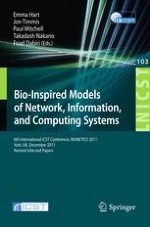This book constitutes the thoroughly refereed post-conference proceedings of the 6th International Conference on Bio-Inspired Models of Network, Information, and Computing Systems (Bionetics). The event took place in the city of York, UK, in December 2011. Bionetics main objective is to bring bio-inspired paradigms into computer engineering and networking, and to enhance the fruitful interactions between these fields and biology. The papers of the conference were accepted in 2 categories: full papers and work-in progress. Full papers describe significant advances in the Bionetics field, while work-in-progress papers present an opportunity to discuss breaking research which is currently being evaluated. The topics are ranging from robotic coordination to attack detection in peer-to-peer networks, biological mechanisms including evolution, flocking and artificial immune systems, and nano-scale communication and networking.
